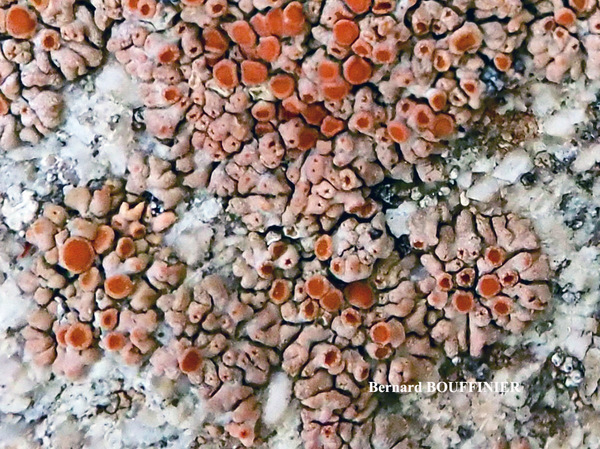Calogaya clauzadeana (Gaya) Nav.-Ros. & Cl. Roux
in Roux & al., Bull. Inf. Ass. Franç. Lich. 47, 1: 30, 2022. Basionym: Caloplaca arnoldii subsp. clauzadeana Gaya - Bibl. Lichenol. 101: 33, 2009
Synonyms:
Distribution:
Description: Thallus crustose-placodioid, episubstratic, rather loosely attached, (210-)270-390 µm thick, forming (4-)7-14 mm wide rosettes, salmon-coloured, often partly whitish due to the presence of abundant pruina. Central areoles 0.3-1.5 mm wide, mostly convex; marginal lobes strongly convex, more or less contiguous or densely imbricate, usually forked, rarely broadened toward tips, 0.4-1.5 mm long, 0.2-0.9 mm wide at apex. Upper cortex well developed, (20-)30-50(-80) µm thick, with a 7-25 µm thick, yellow-orange upper layer, and a 10-60 µm thick, hyaline lower layer, scleroplectenchymatous, of irregularly arranged hyphae, with abundant superficial crystals visible under polarized light; algal layer discontinuous. Apothecia mostly zeorine, sometimes initially lecanorine, abundant, 0.3-1.2 mm across, usually deformed by mutual compression, at first immersed, then sessile or basally constricted, with a flat to strongly convex, brownish-orange, more or less smooth disc, a paler proper margin , and sometimes a usually pruinose, rough, persistent, slightly prominent to finally excluded thalline margin. Thalline exciple 60-150 µm wide; proper exciple 40-90 µm wide, mainly sclero-prosoplectenchymatous, of radially arranged hyphae; epithecium brownish-yellow, 9-12 µm high, K+ red; hymenium colourless, 50-71.5 µm high; paraphyses sparingly branched in upper part 1.5-3.5 µm thick at base, the apical cells 3.5-7.5 µm wide; hypothecium colourless, sclero-prosoplectenchymatous, subtended by a thick algal layer. Asci 8-spored, clavate, functionally unitunicate, apically thickened with a broad internal beak, the inner part of apex and external cap I+ blue, Teloschistes-type. Ascospores 2-celled, polarilocular, hyaline, narrowly ellipsoid, (10.5-)11.5-14(-15) x 4-5(-5.5) μm, the equatorial thickening (“septum”) 3-4(-4.5) μm. Photobiont chlorococcoid. Spot tests: thallus and apothecia K+ red, C-, KC-, P-. Chemistry: thallus and apothecia with parietin (major), fallacinal, emodin, teloschistin and parietinic acid (minor), corresponding with chemosyndrome A of Søchting (1997).Note: on vertical or rain-protected surfaces of calcareous rocks; known from a few stations in Southern Europe, but perhaps not always distinguished in the past.
Growth form: Crustose placodiomorph
Substrata: rocks
Photobiont: green algae other than Trentepohlia
Reproductive strategy: mainly sexual
In underhangs rarely wetted by rain

Predictive model

Bernard Bouffinier - Source: http://www.lichensmaritimes.org/index.php?task=fiche&lichen=1115&lang=en
France, Provence, Saignon

Bernard Bouffinier - Source: http://www.lichensmaritimes.org/index.php?task=fiche&lichen=1115&lang=en
France, Provence, Saignon

Bernard Bouffinier - Source: http://www.lichensmaritimes.org/index.php?task=fiche&lichen=1115&lang=en
France, Provence, Saignon

Bernard Bouffinier - Source: http://www.lichensmaritimes.org/index.php?task=fiche&lichen=1115&lang=en
France, Provence, Saignon

Bernard Bouffinier - Source: http://www.lichensmaritimes.org/index.php?task=fiche&lichen=1115&lang=en
France, Provence, Saignon
Growth form: Crustose placodiomorph
Substrata: rocks
Photobiont: green algae other than Trentepohlia
Reproductive strategy: mainly sexual
In underhangs rarely wetted by rain

Predictive model

Bernard Bouffinier - Source: http://www.lichensmaritimes.org/index.php?task=fiche&lichen=1115&lang=en
France, Provence, Saignon

Bernard Bouffinier - Source: http://www.lichensmaritimes.org/index.php?task=fiche&lichen=1115&lang=en
France, Provence, Saignon

Bernard Bouffinier - Source: http://www.lichensmaritimes.org/index.php?task=fiche&lichen=1115&lang=en
France, Provence, Saignon

Bernard Bouffinier - Source: http://www.lichensmaritimes.org/index.php?task=fiche&lichen=1115&lang=en
France, Provence, Saignon




